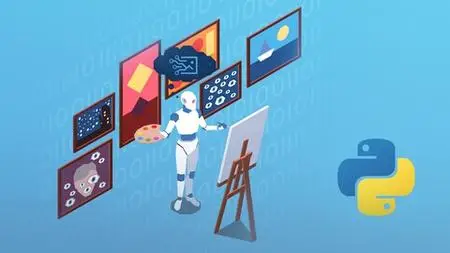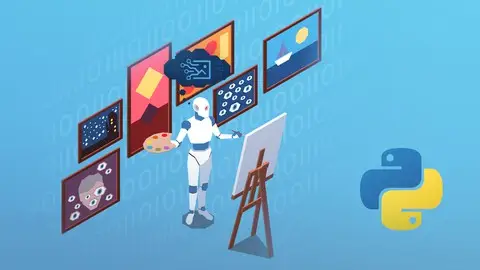Generative Adversarial Networks (Gans): Complete Guide
Published 4/2023
MP4 | Video: h264, 1280x720 | Audio: AAC, 44.1 KHz
Language: English | Size: 4.14 GB | Duration: 9h 54m
Published 4/2023
MP4 | Video: h264, 1280x720 | Audio: AAC, 44.1 KHz
Language: English | Size: 4.14 GB | Duration: 9h 54m
Deep Learning and Computer Vision to implement projects using one of the most revolutionary technologies in the world!
What you'll learn
Understand the basic intuition about GANs
Generate images of digits (0 - 9) using DCGAN and WGAN
Transform satellite images into maps using Pix2Pix architecture
Transform zebras into horses using CycleGAN architecture
Transfer styles between images
Apply super resolution to improve image quality using ESRGAN architecture
Create new faces of people with high quality and definition using StyleGAN
Generate images through textual descriptions
Restore old photos using GFP-GAN
Complete missing parts of images using Boundless architecture
Generate deepfakes to swap faces with SimSwap
Requirements
Programming logic
Basic Python programming
Knowledge about neural networks is desirable, but not mandatory
Description
GANs (Generative Adversarial Networks) are considered one of the most modern and fascinating technologies within the field of Deep Learning and Computer Vision. They have gained a lot of attention because they can create fake content. One of the most classic examples is the creation of people who do not exist in the real world to be used to broadcast television programs. This technology is considered a revolution in the field of Artificial Intelligence for producing high quality results, remaining one of the most popular and relevant topics.In this course you will learn the basic intuition and mainly the practical implementation of the most modern architectures of Generative Adversarial Networks! This course is considered a complete guide because it presents everything from the most basic concepts to the most modern and advanced techniques, so that in the end you will have all the necessary tools to build your own projects! See below some of the projects that you are going to implement step by step:Creating of digits from 0 to 9Transforming satellite images into map images, like Google Maps styleConvert drawings into high-quality photosCreate zebras using horse imagesTransfer styles between images using paintings by famous artists such as Van Gogh, Cezanne and Ukiyo-eIncrease the resolution of low quality images (super resolution)Generate deepfakes (fake faces) with high qualityCreate images through textual descriptionsRestore old photosComplete missing parts of imagesSwap the faces of people who are in different environmentsTo implement the projects, you will learn several different architectures of GANs, such as: DCGAN (Deep Convolutional Generative Adversarial Network), WGAN (Wassertein GAN), WGAN-GP (Wassertein GAN-Gradient Penalty), cGAN (conditional GAN), Pix2Pix (Image-to-Image), CycleGAN (Cycle-Consistent Adversarial Network), SRGAN (Super Resolution GAN), ESRGAN (Enhanced Super Resolution GAN), StyleGAN (Style-Based Generator Architecture for GANs), VQ-GAN (Vector Quantized Generative Adversarial Network), CLIP (Contrastive Language–Image Pre-training), BigGAN, GFP-GAN (Generative Facial Prior GAN), Unlimited GAN (Boundless) and SimSwap (Simple Swap).During the course, we will use the Python programming language and Google Colab online, so you do not have to worry about installing and configuring libraries on your own machine!
Overview
Section 1: Introduction
Lecture 1 Course content
Lecture 2 Introduction to GANs
Lecture 3 How GANs work
Lecture 4 Course materials
Section 2: DCGAN and WGAN
Lecture 5 DCGAN - intuition
Lecture 6 MNIST dataset
Lecture 7 Building the generator
Lecture 8 Building the discriminator
Lecture 9 Loss (error) calculation
Lecture 10 Training
Lecture 11 Visualizing the results
Lecture 12 HOMEWORK and solution
Lecture 13 WGAN - intuition 1
Lecture 14 WGAN - intuition 2
Lecture 15 WGAN-GP - intuition
Lecture 16 Preparing the environment
Lecture 17 Wassertein loss
Lecture 18 Gradient penalty
Lecture 19 Training 1
Lecture 20 Training 2 and visualization
Lecture 21 HOMEWORK and solution
Section 3: cGAN - Pix2Pix and CycleGAN
Lecture 22 cGAN - intuition
Lecture 23 Pix2Pix - intuition
Lecture 24 Map dataset
Lecture 25 Preprocessing the images 1
Lecture 26 Preprocessing the images 2
Lecture 27 Loading the data
Lecture 28 Building the generator 1
Lecture 29 Building the generator 2
Lecture 30 Building the generator 3
Lecture 31 Building the discriminator 1
Lecture 32 Building the discriminator 2
Lecture 33 Generating the images
Lecture 34 Training 1
Lecture 35 Training 2 and results
Lecture 36 Pretrained Pix2Pix with PyTorch
Lecture 37 Facades dataset
Lecture 38 Visualizing the results
Lecture 39 Drawing to photo 1
Lecture 40 Drawing to photo 2
Lecture 41 Night to day
Lecture 42 HOMEWORK and solution
Section 4: Additional content 1: Artificial neural networks
Lecture 43 Biological fundamentals
Lecture 44 Single layer perceptron
Lecture 45 Multilayer perceptron – sum and activation functions
Lecture 46 Multilayer perceptron – error calculation
Lecture 47 Gradient descent
Lecture 48 Delta parameter
Lecture 49 Updating weights with backpropagation
Lecture 50 Bias, error, stochastic gradient descent, and more parameters
Section 5: Additional content 2: Convolution neural networks
Lecture 51 Introduction to convolutional neural networks
Lecture 52 Convolutional operator
Lecture 53 Pooling
Lecture 54 Flattening
Lecture 55 Dense neural network
Section 6: Final remarks
Lecture 56 Final remarks
People interested in creating complex applications using GANs,Undergraduate and graduate students who are taking courses on Computer Vision, Artificial Intelligence, Digital Image Processing or Computer Vision,People who want to implement their own projects using Computer Vision techniques,Data Scientists who want to increase their project portfolio



